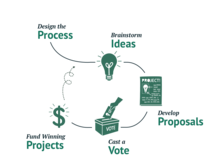According to the Participatory Budgeting Project, a nonprofit aimed to introduce participatory budgeting into more communities; participatory budgeting (PB) is “a democratic process in which community members directly decide how to spend part of a public budget.” In other words, PB enables those who live in the community to identify the issues that matter the most to them and work in tandem with the government to make lasting decisions on how their tax dollars will be spent to make valuable improvements. PB allows for members of the community to take an active role in their own government and make a tangible impact. Anyone who lives within the community is given a voice. Within an explanatory video on PB entitled Real Money, Real Power: Participatory Budgeting, the Participatory Budgeting Project expresses that there are no limits to who can vote within this process; immigrants, whether documented or not, and even sixteen-year olds are eligible and are given a voice. Access to meaningful change should not be discriminatory based on citizenship or age and within this deliberative process all are given access to effect change.
Steps of Participatory Budgeting
Listed below are the four steps as outlined by the Participatory Budgeting Project that demonstrate how PB takes shape within community deliberation. This is a cyclical process that starts again at number one at the beginning of each year.

Brainstorm
- People of the community gather together in large meetings in order to discuss what issues are most important to them to rectify within the community.
Develop Proposals
- Select members of the community team up with experts in the field they are hoping to address.
- Community members express the real needs and desires of a community and
- Work with officials to develop a plan of a feasible way to address them.
Vote
- After the ideas have been narrowed down and fleshed out through the initial steps of the PB process
- members of the community gather to vote on which plans they think will be the most beneficial for the community to allocate their money towards.
- All members of the community are encouraged to vote.
Fund Projects
- The projects that obtain the most votes are funded and residents of the community are able to watch their ideas come to complete fruition.
- Through PB community members can pair effectively with the government to effect meaningful community-wide change.
New York City: Successful Participatory Budgeting
In order to truly begin to understand the real-world benefits of applying this democratic process to your local community it is beneficial to look at a case study of how it was effectively integrated into an American community. While PB has successful roots in Porto Alegre, Brazil and has been successfully adopted throughout Latin American and Europe it was not brought to the United States until 2011 by members of the New York City Council who partnered with the nonprofit the Participatory Budgeting Project. The initial implementation of this program took place in four districts where residents were tasked with deciding how to allocate $1 million dollars in discretionary funds. Since its implementation in 2011 PB has seen exponential growth within New York City, “2014-2015, over 51,000 people voted on the projects they want to see implemented in their communities, and oversaw the spending of approximately $32 million in neighborhood improvements” ("Participatory Budgeting in New York"). The program expanded from four districts to more than 27 in four years and works to benefit millions of lives. This process is truly inclusive of all residents as of those who participated “23% had a barrier to voting in regular elections, including those who had felon convictions or who were under the age of 18” ("Participatory Budgeting in New York"). In application PB allows for all residents to have an equal voice.
Overall, this process is designed for government officials to be able to effectively hear the concerns of their constituents and act responsibly to address these concerns in the way community members feel comfortable having their tax dollars spent. By implementing participatory budgeting into more communities across America the age-old question of "Where do my tax dollars go?" would finally be answered.
